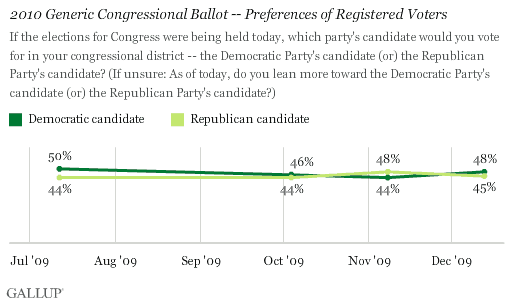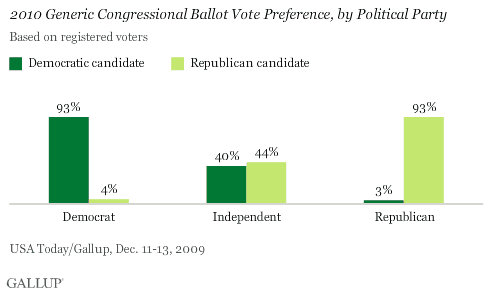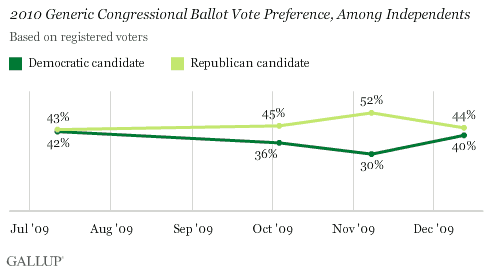PRINCETON, NJ -- Democrats have regained the slim edge they enjoyed earlier this year over Republicans in the latest update of Gallup's generic congressional ballot for the 2010 House elections, and now have a slight 48% to 45% lead among registered voters. After having been behind in July and October, Republicans had moved ahead by four points in a Nov. 5-8 poll conducted just after the off-year elections.

"The current poll reflects the narrowest margin in favor of the Republican candidate among independents since July, when the gap was one point."
The major cause of the movement between November and the current poll is the changing preferences of independents. In the latest poll, conducted Dec. 11-13, independent registered voters tilt only slightly toward the Republican candidate, by 44% to 40%. In the November poll, independents' preference for the Republican candidate was 52% to 30%. Both parties maintain the allegiance of their bases, with 93% of Democratic registered voters preferring the Democratic candidate and an identical 93% of Republican voters preferring the Republican.

The current poll reflects the narrowest margin in favor of the Republican candidate among independents since July, when the gap was one point.

These overall results among registered voters reflect what the election outcome would be if all voters turned out to vote. Usually, turnout among registered voters in midterm elections is much lower than 100%, making the ability of each party to turn out its voters a crucial determinant of the final outcome.
It is too early in the electoral process to make any type of reliable projection of turnout for next fall's elections specifically. Republicans, however, typically enjoy a turnout advantage. Thus, even if Democrats go into the election with a slim advantage in registered voters' preferences -- as is the case in the current poll -- they could quite likely end up with a lower percentage of the overall congressional vote than Republicans receive.
Bottom Line
The current generic-ballot results are similar to those Gallup found in July and October of this year, and indicate that the Republican gain observed just after the Nov. 3 elections was not sustained. Shifts in candidate preference for Congress typically occur primarily among independents, whose "unanchored" status makes them much more vulnerable to short-term events in the political environment than are those who claim allegiance to either major party.
Still, despite the expected short-term fluctuations, the story over the last three months has been the relatively close standing of the two parties in Gallup's monthly trial-heat election ballots. If this continues to be the case next November, Republicans' normal turnout advantage could propel them on Election Day 2010 to a positive margin of the congressional vote over Democrats, with a resulting pickup in House seats. Gallup is tracking the generic House ballot monthly between now and the November 2010 elections; the next update will be in early January.
Survey Methods
Results are based on telephone interviews with 898 registered voters, aged 18 and older, conducted Dec. 11-13, 2009. For results based on the total sample of national adults, one can say with 95% confidence that the maximum margin of sampling error is ±4 percentage points.
Interviews are conducted with respondents on land-line telephones (for respondents with a land-line telephone) and cellular phones (for respondents who are cell-phone only).
In addition to sampling error, question wording and practical difficulties in conducting surveys can introduce error or bias into the findings of public opinion polls.
